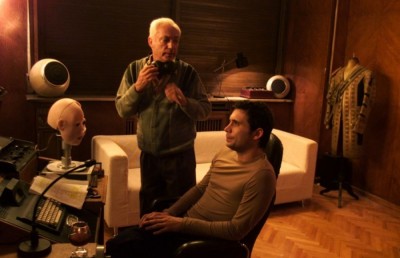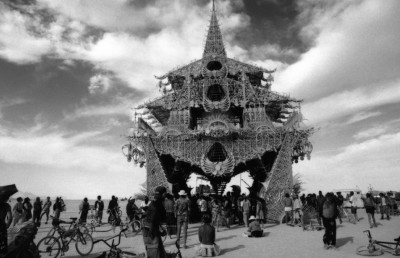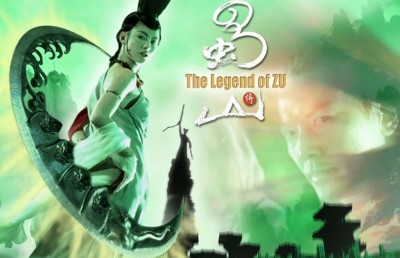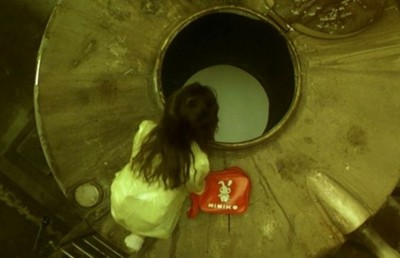Fantasia 2004 Part 2: Selections from the International Programming
Naschy Visits
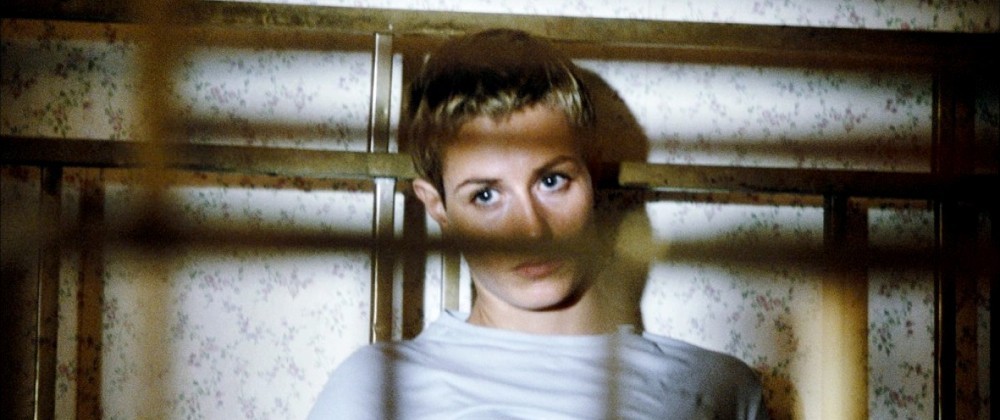
Leaving Asia behind, we begin our selected analysis of the International programming with the aptly titled Haute tension (Alexandre Aja, 2003), a charged up slasher film from France which pits a robotic-like serial killer truck driver, played by the perennially on boiling point butcher from Carne (Gaspar Noé, 1991) and Seul contre tous (Gaspar Noé, 1998) Philippe Nahon, against a small resort community.
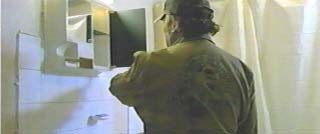
P. Nahon as the “machinic” killer
The main victims are two teenage girls, Marie (Cécile De France) and Alex (Maïwenn Le Besco), and Alex’s parents (Andrei Finti & Oana Pellea), whose country house they visit. The killer attacks the first night, brutally eliminating the parents and holding Alex hostage, which forces Marie into a position of having to attempt to rescue her friend. Early on in the film before the killer attacks there is a key scene which establishes Marie’s sexual longing for Alex. Alex is sitting on a swing on the house grounds taking in some night air. She looks up at Alex’s window and sees her near nude body as she prepares for bed. The lingering nature of the point of view shot and Marie’s facial expression suggests a lesbian attraction which adds a sexual edge to Marie’s attempted heroic act; more importantly, the clear demarcation of the shot as from Alex’s desirous point of view hints at an interpretative leap which may be necessary to understand the film’s startling (and for many people contentious) twist ending: the male physical presence we have been seeing terrorizing the community is slowly revealed to be none other than a projection of Marie’s twisted psychosis; she in fact is the serial killer.
The film does supply subtle hints at the ‘visual’ twist along the way, hints which a second viewing would surely bring out, but many viewers I spoke to after the film could not get passed the feeling that the film did not play ‘fair’ with them. My own feeling goes the other way: the twist was so sudden and brazen that it only added to what would otherwise be a taut, effective horror thriller. Getting back to the earlier mentioned point of view shot: we can now wonder, how much of the film has taken place in Alex’s deranged and disturbed mind (in the grand tradition of The Cabinet of Dr. Caligari (Robert Weine, 1919) and The Creeping Flesh (Freddie Francis, 1973), the film begins with a scene between Alex and her psychiatrist in a medical institution)? If you have the option, see the original French version, and not the dubbed English version, terribly entitled Switchblade Romance (there are no switchblades in the film, and very little two-way romance).
Another effective though far from perfect horror film was the American Shallow Ground (Sheldon Wilson, 2004). In contrast to Haute Tension, which begins calmly, Shallow Ground begins with its strongest moment: a nude teenage boy covered in blood from head to toe and carrying a knife walks determinedly through the woods. The scene alternates from objective shots of the boy to point of view shots moving through the woods until he arrives at a desolate rural police station, which is one day away from being shut down. The two police officers, a man and a woman, are understandably shocked by his arrival, and keep the mute, stony eyed youth at bay until the sheriff arrives. In my description of the opening shots I refrained from using ‘subjective’ to describe the point of view shots moving through the woods because as the story develops we learn that the boy is in fact not one but ‘many’: a singular physical manifestation composed by the spirits of earlier murder victims, a sort of collective return of the repressed who also has a symbiotic relationship to the woods (when he bleeds so does a tree bark). The film’s plot may make perfect sense on paper but becomes hard to follow because of the multiple murderers and intertwining revenge twists. However, this fact also makes the film refreshing in that there are no clear villains and heroes. So the ‘boy’ who seems a potential killer in the opening scene ends up being a cipher for murdered victims; and the police deputy who opens the film as a potential hero is revealed, through a flashback triggered by the ‘boy’s’ touch, as harboring a murderous past. The appearance of Patty McCormack adds an interesting potential ‘intertextual’ nuance to the characterisation of the ‘boy.’ Patty McCormack is best remembered as the child star who provided the first personification of the ‘evil child’ in The Bad Seed (1956). In the Mervyn Leroy MGM film McCormack plays a cute, blond-haired girl whose angelic exterior masks an evil nature. In Shallow Ground the irony works in reverse: the boy’s exterior appears evil, and the film’s style encourages this reading, yet his true inner nature is not one of pure evil or maliciousness (as is the case with _The Bad Seed_’s child character), but as avenging spirit of murdered victims.
McCormack plays a widower who lost her husband and daughter in a dam accident. Although she is in only few scenes, it is evident from the nuances of her first scene that she is not one to turn your back on. In a turn that recalls many gialli, and finds a more direct lineage in Friday the 13th, McCormack is the crazy mother murdering all that had even a small part to play in the accident that led to her family tragedy (the explanation for her violent psychosis is one of the film’s weaker story moments). In his introduction to the film director Wilson cited three films as primary inspirations: The Exorcist (William Friedkin, 1973), The Shining (Stanley Kubrick, 1980), and The Thing (John Carpenter, 1982) [also attending the festival were actors Rocky Marquette (as the boy) and Natalie Avita (Darby Owens), producers Martin Mathieu and (executive) Bill Mendel, composer Steve London and sound designer Richie Nieto]. The influence of these films on Shallow Ground is not overt, a credit to Wilson, but is evident in subtle ways (the telepathy and blood writing from The Shining, the sense of guilt from The Exorcist and paranoia from The Thing). A more direct reference is the outstanding Frailty (Bill Paxton, 2001), which shares with it the rural setting, the narrative twists, and the telepathic nature in which a character’s true evil nature is revealed. Shallow Ground may recall earlier films (The Texas Chainsaw Massacre Tobe Hooper, 1974, is another) but merits credit for providing one of the most original ‘monsters’ in a long while in the character of the primal ‘boy.’
For any self-respecting horror fan, especially Euro-horror fans, a new Argento film is always an occasion, even with the diminishing returns of his later works. The Card Player is no exception. It is a far cry from top notch Argento and lags behind, to my mind, every one of his recent films (Stendhal Syndrome, Non Ho Sonno) except Phantom of the Opera. Which is clearly not saying much, but we are talking about Argento here, and there is always something of value in an Argento film. After an invigorating opening credit sequence montage of wistful, jerky camera movements and macro-close-ups of police office work stations, the film settles down to a procedural serial killer crime film. An unseen killer is kidnapping victims and taunting the police by forcing them to play a live online poker game with the stakes being the victim’s life. If the police win, the victim is let free. If the police lose, the victim is murdered ‘live’ on webcam. Being Italy, no one in the police force knows how to play poker very well, which prompts the police to draft in an unwilling citizen, a young man who the police discover winning in poker at a local casino, to play against the killer. When it comes to sexual seduction, Argento has the touch of mangler, and so the scene where the attractive police detective Anna Mari (Stefania Rocca) seduces the unwilling citizen Carlo Sturni (Claudio Santamaria) in her police office so he accepts the police proposition is as sexy as a dead fish (remember the scene in Stendhal Syndrome where Asia Argento tries to ‘rape’ her boyfriend?). But like all failed seriousness, the scene has a redeeming ‘camp’ entertainment value nonetheless.
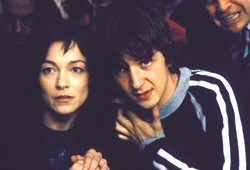
Anna & Carlo
One of the main problems with The Card Player is Argento’s decision to make a cross between an American serial killer film (read Silence of the Lambs, Jonathan Demme, 1986) and an Italian giallo. When the film functions on the former level it fails, mainly because it is too dependent on plot and dialogue (made worse by hearing actors speaking English with a heavy Italian accent), neither of which is an Argento strength. When it functions on the latter level, where Argento can drive off Claudio Simonetti’s fantastic score, Benoît Debie’s (of Irréversible, Gaspar Noé, 2002) restless camera, and just worry about making the setpiece inventive, the film works well. As in one of the film’s best scene’s, where police detective Anna Mari is stalked by the killer in her apartment. In this scene we see one of Argento’s key thematics, the persistence and driving force of the gaze (the camera’s, the killer’s, the victim’s, the audience’s), worked to great effect. First off, the presence of the killer is subtly introduced as a reflection in a round object in Anna’s apartment. As the chase begins Anna shuts off the lights to make vision a problem for the killer (and by extension the audience); and Argento introduces an unsettling omniscient vision with selected overhead viewpoint shots of Anna crawling along the floor of her apartment. By contrast, ‘vision’ is mundane and visually dull during the police station/poker game scenes, where the best Argento can do during the scenes is cut between the computer screen and the impotent reactions of the people standing behind the card player looking at the computer screen. These scenes at the police station, especially the impromptu party scene to celebrate the poker victory which saved the police detective’s daughter, provide some wonderful unintentional humour.
It is also disconcerting when the hinge on which the plot’s central twist depends just does not make sense. Anyone familiar with the giallo would probably have figured out that the killer was close to home –a police detective- but the twist depends on the killer having an alibi, and the alibi is that the video poker games were taped and presented hours later, which enabled the killer to be in the police station watching the seemingly live act. But the nature of the online poker game, where five down turned cards are turned up one at a time in alternating fashion by the killer and the police makes the taped premise downright impossible! Getting back to my earlier point, if this were a giallo loaded with inventive setpieces and sleazy turns at every corner, the huge plot hole would be acceptable. In a more character/plot driven narrative, it is not.
It was nice to see Montreal’s own comic book artist/musician Rick Trembles get a much deserved spotlight at Fantasia 2004, with the world premiere of his hilarious autobiographical animated short Rick Trembles’ Goopy Spasms, which raises scatological humor to an altogether new high (low?); and the book launch of FAB press’ compilation book of Rick Trembles’ always astute and unique comic strip film reviews, Motion Picture Purgatory. Fittingly, given that Trembles wrote the description for this film in the Fantasia program book, the only film which could compete with Goopy Spasms for outright shock value is Curt McDowell’s 1975 underground (very underground) classic Thundercrack! (not to imply that either film had only shock value as a merit). The single word to best describe Thundercrack!: Wow! Thundercrack! is this year’s Reflections of Evil (Damon Packard), which took Fantasia by storm last year: personal, irreverent, and unique beyond one’s imagination. It begins on a typical dark, stormy night on which a group of young, sexually charged people become stranded and spend the evening at the house of a grotesque Southern Belle, Mrs. Gert Hammond (played by Marion Eaton). What follows is anything but typical. Would you believe Whatever Happened to Baby Jane? (Robert Aldrich, 1962) meets The Old Dark House (James Whale, 1932..James Whale would surely have approved), meets hard core porn (including gay porn)? A horny Mrs. Hammond masturbates with a cucumber while spying on a young male guest masturbating with one of those space-age 1970’s penis enlargener tubes (the good old pre-implant penis enlargener days!). A romance between a man named Bing (played by George Kuchar) and a gorilla he once slept with ‘unknowingly’ when drunk. And a typically gothic conclusion which reveals the mansion’s dark secrets: the dead pickled remains of Mrs. Hammond’s husband and her son, physically deformed with elephantitis testicles, kept locked in a room. Hard core porn collides with heady melodramatic camp in the tradition of Curtis Harrington, Kenneth Anger, the Kuchar Bros., John Waters, and Andy Warhol, like two 16-wheelers at top speed. And somehow it all works. Click here to order the newly minted, uncut DVD.
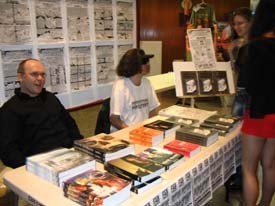
Harvey Fenton (FAB) & Rick Trembles book signing
Blueberry (Jan Kounen, 2004) represents (if memory serves me right) a Fantasia first: a western, albeit a psychedelic revisionist western. Far from perfect, Blueberry is an entertaining mishmash of epic western and counterculture ideology. The film opens with some great aerial shots of the mountains and desert landscape before giving way to a traditional (of sorts) revenge Western, with the central caveat being the substitution of the conventional gunslinger showdown with a ‘psychic-spiritual’ showdown between the two central protagonists, US Marshal Mike S. Blueberry (Vincent Cassel) and gunslinger Wallace Sebastien Blount (Michael Madsen). Juliette Lewis also stars as a bar singer, Maria Sullivan, who falls in love with Blueberry. In a prologue a young Mike Blueberry (Hugh O’Conor) is emotionally scarred when a hooker he cares for is apparently murdered by gunslinger Michael Madsen. We learn later at the end of the film, in a flashback that sets up the drug-induced ‘trip’ showdown, that it was Blueberry who shot the hooker, and not Blount.
One of the drawbacks of the film, and it is a major one, is the representation of the Natives, who are used as not much more than ciphers of ‘drug-enlightenment.’ We get no insight into their culture outside of them as A) guardians of the Sacred Mountain, where the climax takes place and B) ‘knowers’ of the drug therapies which can alter one’s state of consciousness, heal, and make one become a better warrior.
There are large plot holes as well. For example, the film establishes that it is next to impossible to get to the Sacred Mountain because it is stringently guarded by the Cherokee Native Americans. But in the end, for the necessities of the climax, all three characters, Blueberry, Blount, and Maria, get there without any problems within minutes of each other. As stated, the film replaces the classic gun showdown with a psychic, drug-induced ‘trip’ showdown. I did not care for the first part of the ‘trip,’ which included ludicrous images of dime store psychosis (morphing insects, spiders, etc.), but after the camera ‘enters’ Blueberry’s eye, the imagery changes to abstract, Mandelbrot-styled patterns that flicker spasmodically to render a trance-like effect (no doubt influenced by _2001: A Space Odyssey_’s stargate sequence). It is unfortunate that just as the trance effect was taking hold and I was beginning to ‘lose’ myself in the kaleidoscopic imagery, the scene came to an end. Perhaps director Kounen did not have the courage of his convictions to extent this abstract section to experimental proportions. In any case, any film with Ernest Borgnine as a wheelchair bound sheriff and Juliette Lewis singing badly can’t be all bad!
Several pages later and there are still many films which have left an indelible mark at Fantasia 2004 that have not been discussed; such as the rare screening of Jack Smight’s 1973 made for television Frankenstein: The True Story, presented in an excellent 16mm print by local film impressario Phillip Spurrell of the Film Society; or perhaps the most enjoyable film of the festival, the wonderfully clever zombie comedy/buddy film Shaun of the Dead (Edgar Wright, 2004); the exuberant Shaw Brothers’ 8 Diagram Pole Fighter (Chia-Liang Liu, 1983); the joyful (at least for Michael Hui fans) Fantasia (Ka-fai Wai, 2002); and the unspeakably queasy and intellectually challenging serial killer film with echoes of Peeping Tom (Michael Powell, 1960), Man Bites Dog (Rémy Belvaux, André Bonzel, 1992), and American Psycho (Mary Haron, 2000), The Last Horror Movie (Julian Richards, 2003). However, I don’t want to leave the wrong impression: not every film that graced the Fantasia screens was a masterpiece. It can be expected that with a schedule of over 100 features there are bound to be some clunkers along the way. Based on the films that I have seen, candidates for clunker of the year would include Ginger Snaps: The Beginning (Grant Harvey, 2004) [whose 19th century period recreation was described by more than one viewer as feeling like one of those Canada Heritage spots]; the Korean Natural City, not that it was so bad but for failing so drastically to attain even a fraction of its potential as big budget science-fiction; the Vietnamese Oan Hôn (Victor Vu, 2004) [clearly this subdued ghost story trilogy was not helped by the bad video that was projected]; and I Pass for Human (Chris D. 2004) [heartfelt and personal no doubt, but letdown by the script, acting, and flat video aesthetics].
I have only briefly mentioned some of the many guests who have accompanied the films at Fantasia. Although I’m sure most Fantasia fans would be more than happy to experience the films alone, it adds a level of intimacy to share the film with one or more of its creative participants. The manner in which guests give of themselves varies greatly, but from my experience with past Fantasia editions, guests, both from the media and the production side, seem to truly enjoy themselves at Fantasia, and consequently are gracious and open. Credit for some of this goes to the Fantasia organizers, programmers, and staff, not to mention the fans, whose enthusiasm and energy no doubt lift guests from their weary travels. Fantasia must also be applauded for the way they immediately place guests into the ambience of the festival (the audience, the city, the other guests).
As far as treats for horror fans go, the appearance of the great Spanish horror film icon Paul Naschy (real name Jacinto Alvarez Molina) at Fantasia was right up there with the appearance of Brazil’s Jose Mojica Marins (aka Coffin Joe) a few years back. Although Naschy was far less dramatic than Marins, both men were consummate professionals who embraced their fans with humility and humor. Naschy’s cinematic presence at Fantasia dates back to last year’s irreverent performance in Mucha Sangre (Pepe de las Heras, 2002). As a guest this year Naschy was honored by a double-bill of two older classics, The Werewolf vs. the Vampire Woman (Leon Klimovsky, 1970) and Dracula’s Greatest Love (Javier Aguirre, 1972), and the international premiere of his latest film, Rojo Sangre (Christian Molina, 2004). Rojo Sangre was described by Naschy in his introduction as a ‘realistic film but with a fantastic edge.’ The film is a semi-autobiographical tale of a former horror movie actor who is so desperate for work that he agrees to a job as a glorified doorman who performs in period costume at a chic nightclub. Borrowing liberally from Faustian legend and such hyperbolic revenge tales as Theatre of Blood (Douglas Hickox, 1973) and The Abominable Dr. Phibes (Robert Fuest, 1971), the film is a stylish condemnation of the contemporary Spanish film industry which will hold a bittersweet feel for Naschy fans.
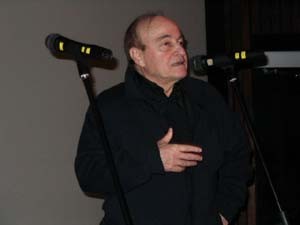
Paul Naschy introducing….
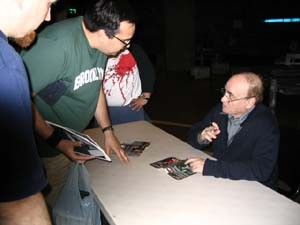
….signing autographs
It was also a pleasure to revisit the two early Naschy classics on a big screen. Unfortunately, because of the extra late start time (well past midnight) the screening was not as well attended as Rojo Sangre. Even with the late start time, Naschy showed his true warrior colors by insisting to introduce the first film, The Werewolf vs. the Vampire Woman, and stay for a Q & A. In his introduction to The Werewolf Naschy described the film as being “anarchistic,” which can be explained in terms of its historical pedigree as one of the first Spanish horror films under Franco’s dictatorship, its style (a narrative which values mood and atmosphere over plot and dialogue), and its thematics (violent eroticism). It was a pleasure to listen to Naschy’s bemused reaction to seeing this American release version for the first time, complaining of the censored scenes, the poor dubbing, the inappropriate dialogue, and the changed music score.
Every year has its ‘special’ guest, someone who leaves their mark in some way shape or form (Richard Stanley, Nacho Cerda, Ching Wan Lau, and Ray Wise come to mind from earlier years). This year that person was undoubtedly Udo Kier, who surely lived up to whatever expectations one may have had based on his wonderfully eclectic, bizarre, and cultish screen performances. Kier was here with two films, Gate to Heaven (Veit Helmer, 2003) and One Point Zero (Jeff Renfroe and Marteinn Thorsson, 2004). Kier’s performances in both these films were of the secondary character nature, although he has made a career out of making an impression with such otherwise small roles. The latter film is by far the more interesting, an existential science-fiction/noir take on urban paranoia (an interview with the two directors will appear in an upcoming issue), but Kier’s best performance (not counting his off-screen ones!) was found in a short film which he brought along himself and asked be shown before one of the features, Mrs. Meitlemeihr (directed by Englishman Graham Rose). Kier plays Adolf Hitler in an alternate history scenario in which Hitler survives and is stranded in London after World War 2, holed up in a shabby apartment waiting for news from fellow Nazis hiding in Argentina. Hitler dresses in drag whenever he has to leave his apartment. On a trip to the post office “Hitler” is spotted by his neighbor, an elderly Jewish man, who takes a liking to “Mrs. Meitlemeihr” and forces himself to dinner that night, setting up a contrived irony that is played more for absurdist humor than political message. The Jewish man’s dinner time sexual advances and Holocaust horror stories eventually take their toll on Hitler’s front, recalling the famous story of the scorpion and the frog (just as it is in the scorpion’s nature to sting the frog, it is in Hitler’s nature to despise the Jewish man, regardless of the consequences). Kier’s performance as Hitler slowly reveals the fierce anti-Semitism hovering behind his disguise is wonderful; as is the film’s visual style marrying postwar realism with maniacal expressionism.
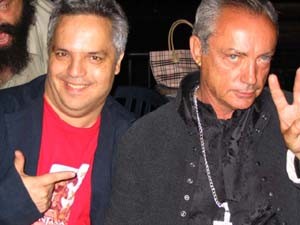
FanTasia’s ‘mascot’ Daniel & Udo
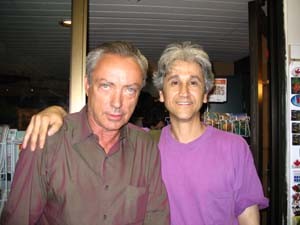
Udo with the author
But Kier’s on-screen performances may well have to take a back seat to his offscreen performances, which will no doubt become legendary in Fantasia annals. In any case, nobody will forget Kier’s introductions, his question and answer periods, his holding court at local bars, and his love affair with one “Jean-Pierre” (a knapsack in the shape of a stuffed animal). Kier made his mark on Montreal, but would fans have expected anything less?
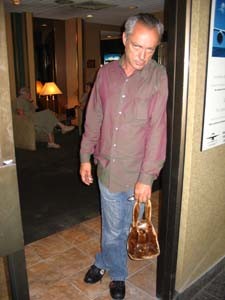
Fantasia 2004 Part 1: Selections from Japan (mainly) and Korea



